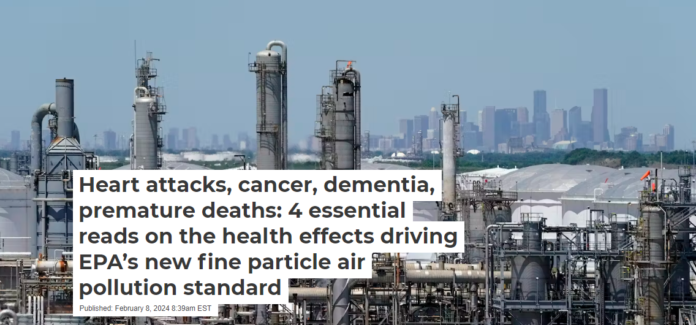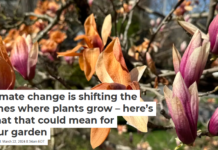

Jennifer Weeks, The Conversation
The U.S. Environmental Protection Agency has announced a new standard for protecting the public from fine particulate air pollution, known as PM2.5 because the particles are smaller than 2.5 millionths of a meter. These minute particles can penetrate deeply into the body and have been linked to many serious illnesses.
The new rule sets an annual limit of 9 micrograms per cubic meter of air, down from the previous level of 12 micrograms. States will be required to meet this standard and to take it into consideration when they evaluate applications for permits for new stationary air pollution sources, such as electric power plants, factories and oil refineries.
Under the Clean Air Act, the EPA is required to set air pollution standards at levels that protect public health. In the four articles that follow, scholars wrote about the many ways in which exposure to PM2.5 contributes to cardiovascular disease, lung cancer, other illnesses such as dementia, and premature deaths.
1. An alarming array of health effects
Scientists have known since the 1993 Six Cities Study, which showed that people were dying faster in dirty cities than in clean cities, that exposure to PM2.5 increased the risk of lung cancer and heart disease. Subsequent research has linked fine particulates to a much broader range of health effects.
Once a person inhales PM2.5, “it causes an inflammatory response that sends signals throughout the body, much as a bacterial infection would,” wrote public and environmental health scholars Doug Brugge of the University of Connecticut and Kevin James Lane of Boston University. “Additionally, the smallest particles and fragments of larger particles can leave the lungs and travel through the blood.”
In Brugge and Lane’s view, evidence that PM2.5 could affect brain development, cognitive skills and children’s central nervous systems is particularly notable. They termed fine particle pollution an urgent global health threat.
“Developed countries have made progress in reducing particulate air pollution in recent decades, but much remains to be done to further reduce this hazard,” they observed. “And the situation has gotten dramatically worse in many developing countries – most notably China and India, which have industrialized faster and on vaster scales than ever seen before.” https://player.vimeo.com/video/279226940 PM2.5 particles are small enough to evade many of the body’s defenses.
2. Aging the brain
Medical researchers are looking closely at air pollution as a possible accelerator of brain aging. University of Southern California preventive medicine specialist Jiu-Chiuan Chen and his colleagues have found that older women who lived in locations with high levels of PM2.5 suffered memory loss and Alzheimer’s-like brain shrinkage not seen in women living with cleaner air.
Chen and his colleagues compared brains scans taken at five-year intervals of older women who lived in areas with varying levels of air pollution.
“When we compared the brain scans of older women from locations with high levels of PM2.5 to those with low levels, we found dementia risk increased by 24% over the five years,” Chen wrote.
More alarmingly, “(T)hese Alzheimer’s-like brain changes were present in older women with no memory problems,” Chen noted. “The shrinkage in their brains was greater if they lived in locations with higher levels of outdoor PM2.5, even when those levels were within the current (2021) EPA standard.”
3. Disadvantaged communities have dirtier air
As researchers in environmental justice have shown, facilities such as factories and refineries often are concentrated in low-income neighborhoods and communities of color. This means that these areas are exposed to higher pollution levels and face heavier related health burdens.
Regulations put in place under the Clean Air Act have greatly reduced levels of harmful air pollutants across the U.S. over the past 50 years. But when University of Virginia economist Jonathan Colmer and public policy scholar Jay Shimshack analyzed data tracing PM2.5 concentrations at more than 8.6 million distinct U.S. locations from 1981 through 2016, they found that the areas that were most polluted in 1981 remained the dirtiest nearly 40 years later.
“In 1981 PM2.5 concentrations in the most polluted 10% of census tracts averaged 34 micrograms per cubic meter,” the authors reported. “In 2016 PM2.5 concentrations in the most polluted 10% of census tracts averaged 10 micrograms per cubic meter. PM2.5 concentrations in the least polluted 10% of census tracts averaged 4 micrograms per cubic meter.” In other words, while all areas had cleaner air, people in the most polluted areas still were exposed to PM2.5 levels more than twice as high as people in the cleanest zones.
“For decades, federal and state environmental guidelines have aimed to provide all Americans with the same degree of protection from environmental hazards,” Colmer and Shimshack note. “The EPA’s definition of environmental justice states that ‘no group of people should bear a disproportionate share of the negative environmental consequences.’ On this front, our research suggests that the United States is falling short.”
4. Fine particle pollution hurts wildlife too
Like the proverbial canaries in coal mines, wild animals can show effects of exposure to pollution that offer broader warnings. One example is wildfires, which produce high levels of gases and particulate matter.
Cornell University conservation biologist Wendy M. Erb was studying wild orangutans in Indonesian Borneo when that island suffered large-scale wildfires. Orangutans are semi-solitary animals that communicate with each other through long, booming calls in the tropical forests where they live.
During the fires and for several weeks after the smoke cleared, Erb and her colleagues found that four male orangutans they were following called less frequently than usual – about three times daily instead of their usual six times. “Their voices dropped in pitch, showing more vocal harshness and irregularities,” Erb reported. “Collectively, these features of vocal quality have been linked to inflammation, stress and disease – including COVID-19 – in human and nonhuman animals.”
Erb hoped to see further study of how toxic smoke affects wildlife. “Using passive acoustic monitoring to study vocally active indicator species, like orangutans, could unlock critical insights into wildfire smoke’s effects on wildlife populations worldwide,” she observed.
Editor’s note: This story is a roundup of articles from The Conversation’s archive.
Jennifer Weeks, Senior Environment + Cities Editor, The Conversation
This article is republished from The Conversation under a Creative Commons license. Read the original article.



















